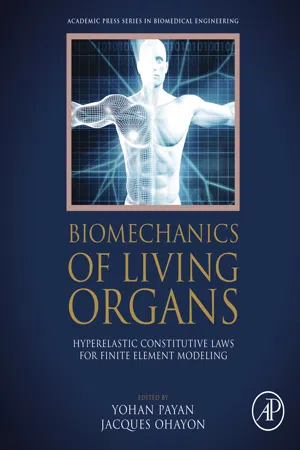
Biomechanics of Living Organs
Hyperelastic Constitutive Laws for Finite Element Modeling
Yohan Payan,Jacques Ohayon
- 602 pages
- English
- ePUB (adapté aux mobiles)
- Disponible sur iOS et Android
Biomechanics of Living Organs
Hyperelastic Constitutive Laws for Finite Element Modeling
Yohan Payan,Jacques Ohayon
À propos de ce livre
Biomechanics of Living Organs: Hyperelastic Constitutive Laws for Finite Element Modeling is the first book to cover finite element biomechanical modeling of each organ in the human body. This collection of chapters from the leaders in the field focuses on the constitutive laws for each organ.
Each author introduces the state-of-the-art concerning constitutive laws and then illustrates the implementation of such laws with Finite Element Modeling of these organs. The focus of each chapter is on instruction, careful derivation and presentation of formulae, and methods.
When modeling tissues, this book will help users determine modeling parameters and the variability for particular populations. Chapters highlight important experimental techniques needed to inform, motivate, and validate the choice of strain energy function or the constitutive model.
Remodeling, growth, and damage are all covered, as is the relationship of constitutive relationships of organs to tissue and molecular scale properties (as net organ behavior depends fundamentally on its sub components). This book is intended for professionals, academics, and students in tissue and continuum biomechanics.
- Covers hyper elastic frameworks for large tissue deformations
- Considers which strain energy functions are the most appropriate to model the passive and active states of living tissue
- Evaluates the physical meaning of proposed energy functions
Foire aux questions
Informations
Hyperelasticity Modeling for Incompressible Passive Biological Tissues
† University of Savoie Mont-Blanc, Engineering School Polytech Annecy-Chambéry, Le Bourget du Lac France
Abstract
Keywords
1 Introduction
Table des matières
- Cover image
- Title page
- Table of Contents
- Copyright
- Contributors
- Preface
- Part 1: Constitutive Laws for Biological Living Tissues
- Part 2: Passive Soft Organs
- Part 3: Active Soft Organs
- Part 4: Musculo-Skeletal Models
- Index